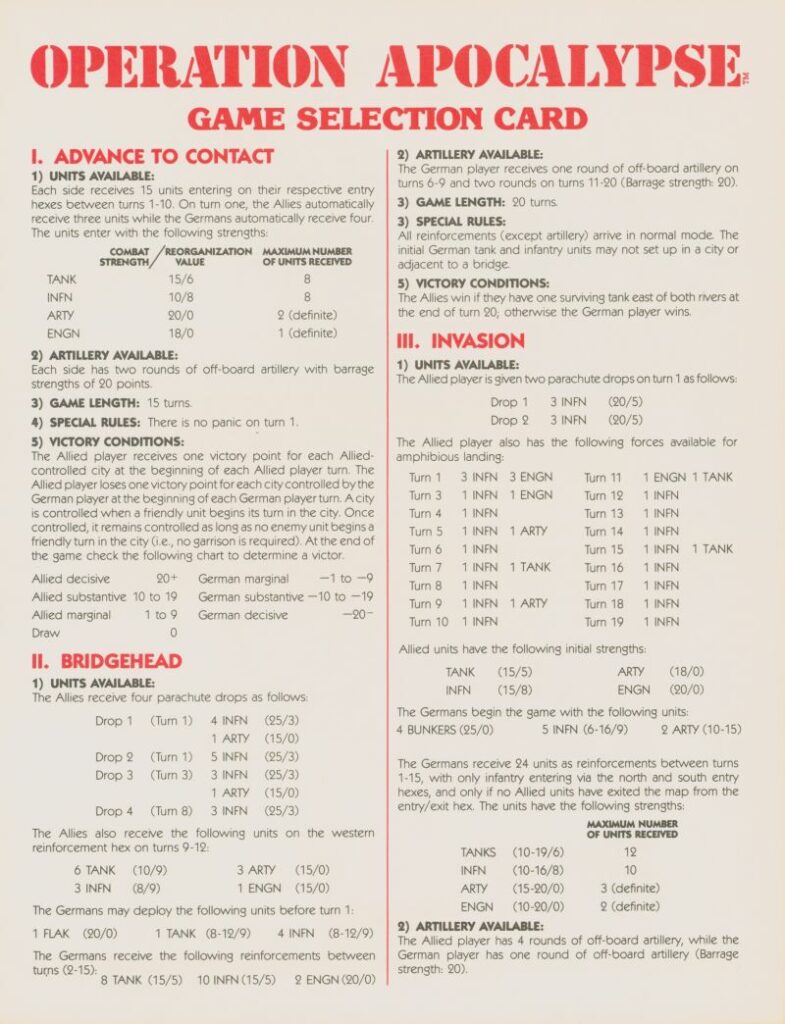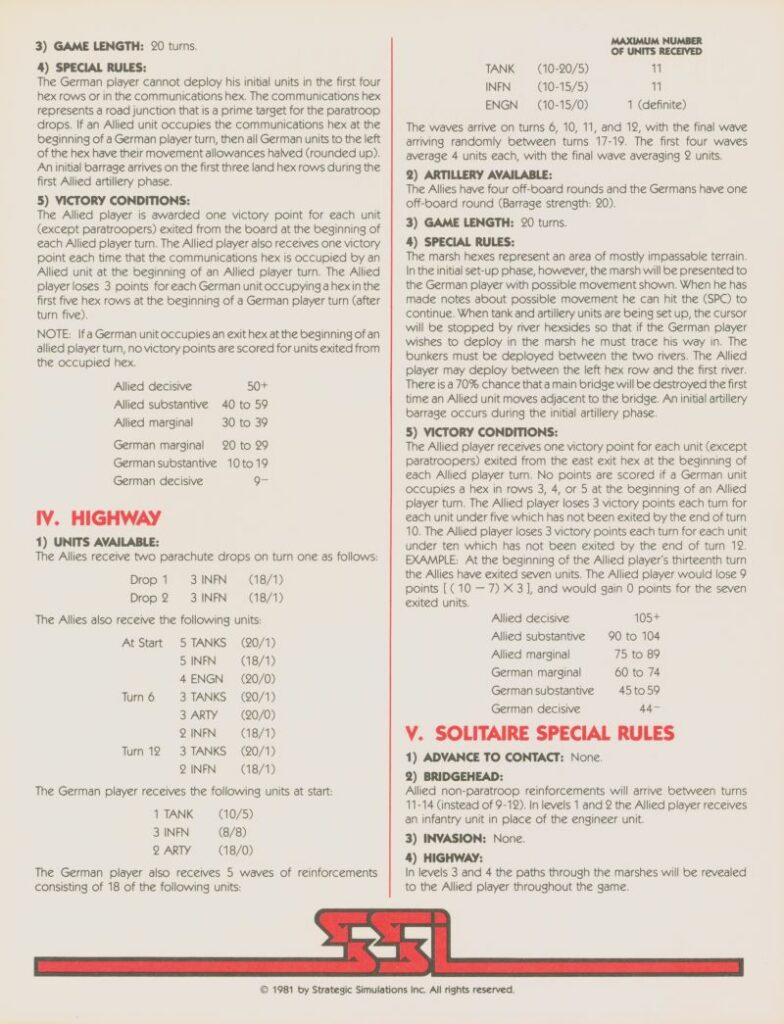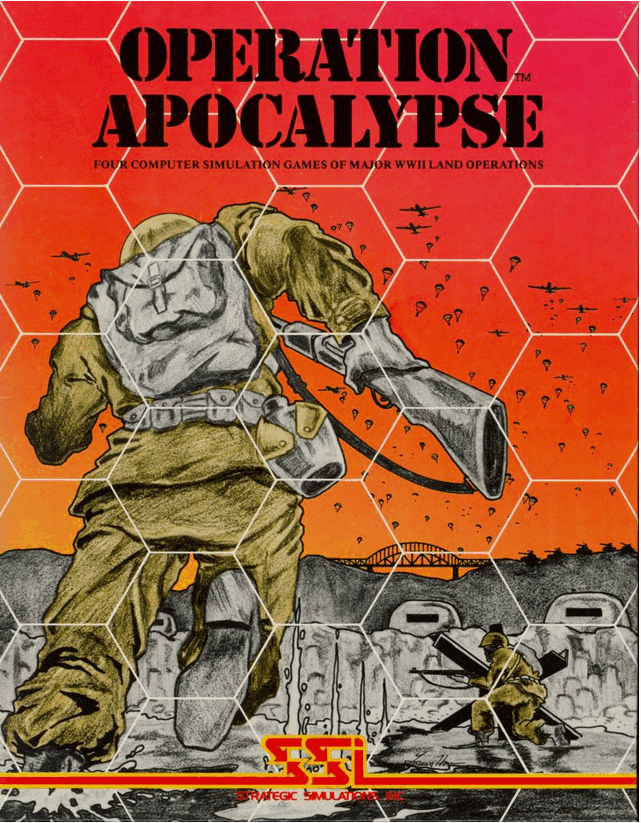
Operation Apocalypse by Roger Keating, Australia, published by SSI, USA
First release : March 1981 on Apple II
Tested on : Apple II
Total Hours Tested : 5
Average duration of a scenario : 1 hour
Difficulty: Average (2/5)
Would recommend to a modern player : Maybe, if you love Panzer General type of games and don’t mind graphics.
Would recommend to a designer : Maybe, for mode & for scenario design
Final Rating: Well-designed, but obsolete.
This article was edited on 03/10/2021 with integration of information I received from Roger Keating and update of the ratings to my new system. You can read the AAR here.
Operation Apocalypse is the second game by Roger Keating and a follow-up to Rebel Force (Keating’s game embedded in Computer Conflict). After accepting to publish Rebel Force, Joel Billings invited Keating to travel from Australia to visit his office in California, which Keating did around Christmas 1980. They used this opportunity to talk about future cooperation, and agreed on what became Operation Apocalypse.
Keating’s legal situation was complicated : he was visiting on a tourist visa, which could theoretically be extended, but not turned into a work visa. No matter, Keating would not receive a salary, no, he would receive advance royalties every week on the product that, incidentally, he was working on his own free time while visiting his good SSI friends in their office. All this while sleeping at John Lyon’s place, occasionally helping him on the code for Torpedo Fire.
With less than three months to make a game from scratch and almost alone (though Billings helped a great deal on the design), Keating worked 7 days a week. But it had its perks : Keating was in practice treated like a full-time SSI employee and Billings shared with him everything he knew about running a video game company (something that would certainly help Keating later!).
Ultimately, the game was completed the last day of Keating’s visa – he completed the game, then rushed to the airport – making it to his plane just on time !
A lot was promised, and a lot was delivered – I had some fun by comparing the game’s teaser and reality :
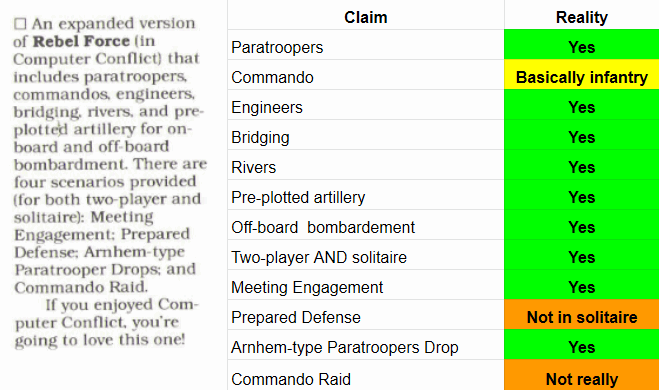
The lineage to Rebel Force is very obvious but from SSI’s point of view, Operation Apocalypse was considered in a different category. Computer Conflict was sold at the lower SSI price point ($40), Operation Apocalypse was priced at the “normal” $60. The game box was of comparable quality with any other tier 1 SSI game ; in my opinion the quality of the art is even better than anything SSI had released prior to this game.
The box included :
- The rule book,
- A game selection card describing the scenarios at length,
- Two “maps”, in reality an empty grid on which you can take notes,

- Some pens to write on that map,
- A mode reference card, which I will show and explain later.
The most important change from Roger Keating’s point of view may have been the introduction of two-players gameplay. Faced with the task of implementing multiplayer, Keating took several design decisions that even in 1981 were unforgivable in their impact on solitaire gameplay, especially since they had been solved by every prior SSI game, including the first one, Computer Bismarck.
There were two versions for Operation Apocalypse, : the only difference between the original version and the 1.1 version (released late 1981) is that the latter is significantly faster thanks to “faster chaining”. Also called RDOS by SSI,this was, er, some technical shenanigan that was applied to most of the early SSI releases (Computer Bismarck, Cartels & Cuththroats, The Warp Factor, Computer Air Combat, …) in their 1.1 versions.
One final more personal comment about the game – this is the first game so far that plays like a distant ancestor to Panzer General, whether or not it actually was.
A. Immersion (Settings & Aesthetics)
The game is obviously a bit more localized in time & space than in Rebel Force, yet it does not commit : it is not Operation Overlord, it is Invasion and a generic beach. It is not Arnhem, it is “a large-scale para-drop over vital bridges“. The weird order in which the scenarios are proposed does not help : you are not playing as part of a grand campaign, you play several disconnected engagements. Nonetheless, the scenario design makes the context unambiguous, and Bridgehead in particular really feels like a desperate battle against time.
The graphics are more diversified than in Computer Conflict, I appreciate the special effect when the planes are dropping airborne troops (I did not expect something that cool in 1981) but, well, let’s be honest in the grand scheme of things it is not much better. Nitpick : I lost the asymmetry from Computer Conflict, now the German tanks look exactly like the Allied tanks, and none look like anything that was used in WW2.
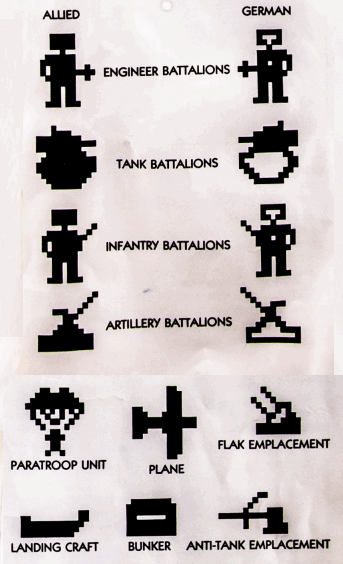
Rating : Bad
B. UI , Clarity of rules and outcomes
In my Rebel Force review, I said :
The unequivocally bad UI issue is that you don’t know your unit’s strength until it is their turn (including how much damage they received at the end of a combat or due to a mine !), and it is really hard to plan a strategy when you do not remember if the tank company you want to use for support is at full strength or almost totally depleted. In addition, the game does not remind you in which order your units will move, so it is quite hard to optimize movements on the fly to let your depleted units retreat while making sure not to leave a gap at the end of your turn.
I would write almost the same comment, minus the mention of the mines, absent in Operation Apocalypse, and with the caveat that you can postpone playing an unit. Keep in mind you can postpone only once per unit per turn. So if you need a specific order for three units you are out of luck.
Another major irritant in Rebel Force was that you had limited time to play each individual unit. Thankfully, this is gone… except when you have to choose each unit’s “mode” (attack, defense, transport, …) at the beginning of the turn. I am surprised by Keating’s decision to remove the timer that existed, and add it back on a different feature.
But all these issues are minor compared to the baffling decision about “hidden” units. You see, when an unit arrives on the battlefield, you can choose in most cases whether it will arrive Hidden or not. If the unit is not hidden, your opponent will see it on the battlefield. If the unit is hidden, then neither you nor your opponent will see it. You are supposed to remember where it is, taking notes on the map provided with the game. Of course, given that by mid-game you could have as many as 15 or 20 units on the battlefield so it is not a trivial task.
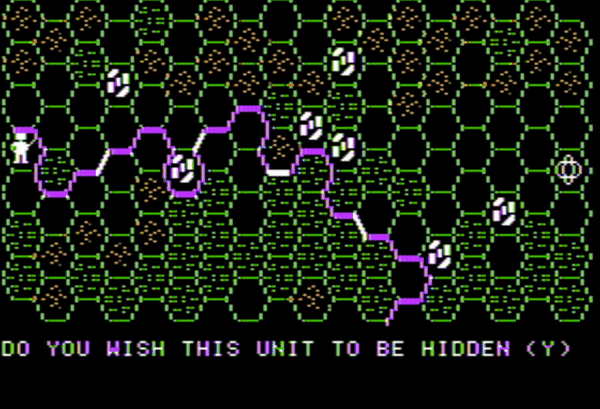
Worse, this behaviour would be maybe understandable in multiplayer (though there are many more comfortable solutions, like asking player #2 not to look at the screen while you play), but it also applies against the AI : either you tell the AI where your units are, or you have to play blind. Of course, I could not be bothered and it would have produced a pretty terrible AAR.
As for the AI movement, you decide upon choosing your scenario whether the AI’s moves will be hidden or not, but even in the former case you will have some hints (check the bottom right corner in the gif).
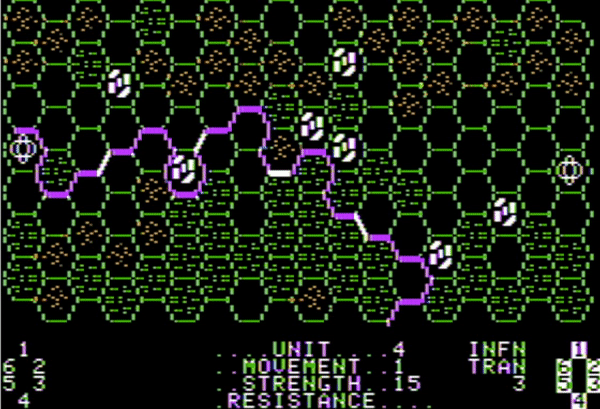
For this reason, I cannot rate Operation Apocalypse better than Rebel Force on this part.
Rating : Very poor
C. Systems
I will cover the systems in length, as Keating would build on them for his future games : Southern Command and the very successful 1985 series (Germany 1985, RDF 1985, Baltic 1985, Norway 1985).
Operation Apocalypse can be described as a game with 2 layers : one layer coming almost directly from Rebel Force, one layer added on top.
1. What comes from Rebel Force
As in Rebel Force, units fight by comparing their strength and then throwing a die on the combat result table (CRT).

The CRT looks a bit different from the one in Rebel Force (4 more columns, but every other column similar to the previous one), but the principle is the same.
And then, like in Rebel Force, it is column shift time :
Due to terrain : Forests are a bit less supreme compared to Rebel Force but otherwise it looks fairly similar :

Due to unit-type : Unlike in Rebel Force, bonus is asymmetric depending on whether you are in attack or defense

Due to support : +2 column shifts for each additional friendly unit also in contact with the target, -2 column shifts for each additional hostile unit next to the attacker.
Just like in Rebel Force, you don’t know exactly the strength of the enemy (except if you watched them during their turn ^^) and the column on which the battle occurs is indicated to you by the level of “resistance”. You can force the enemy to retreat, and if the enemy retreats or is destroyed you can follow-up and fight again.
2. What’s new on the table.
“Mode” is the most important new feature that would be kept in Keating’s future games. Mode is chosen at the beginning of the turn :
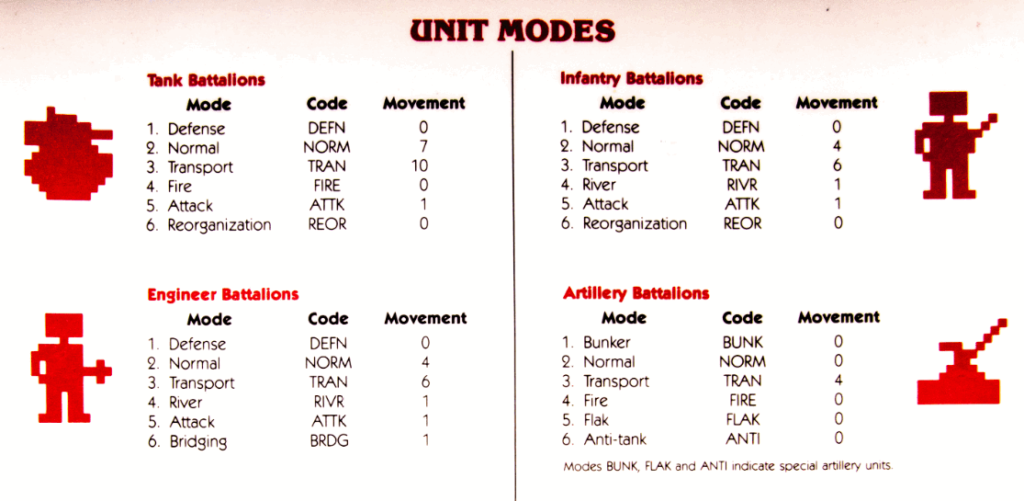
Mode has three impacts :
- One impact on movement speed,
- One impact on column shift, which adds up to the rebel force logic,
- In most cases, special effects :

The reorganization mode is a bit peculiar – in Operation Apocalypse every infantry and tank unit has a “reorganization value” defined in the scenario : typically it is very low for paratroopers, high for the starting German troops and average for reinforcements. The higher the value, the faster a unit can heal (including from the first turn, there is no “upper limit”), but as a unit heals its organization value decreases forever.
Operation Apocalypse also adds artillery in 2 different ways :
- Off-board bombardment : the player chooses the target at the beginning of the turn, and it will take effect at the beginning of the next turn,
- Artillery units, easy to destroy (they always receive double damage) but powerful, their range is 6 hexagons and they typically cause 3-5 damage to infantry and 0-3 damage to tanks,
Movement has been significantly modified compared to Rebel Force. Units stop when they come in contact with an enemy and must attack it (in Rebel Force, there was a combat, after which you could carry on moving). A unit that starts its turn in contact with an enemy has fewer movement points but it can move away. The game adds a really smart feature : every 5th turn is a night turn, during which units are not forced to stop when they come in contact with the enemy. That can really change the tactical situation.
And to finish this long description of the systems, every turn, each unit has 10% chance to “panic”. If a unit panics, then its movements are totally random for this turn. According to the manual the “panic” actually represents everything that can bring confusion to the battlefield : panic of course, but also misunderstood orders, error in navigation, … It is rare enough not to be frustrating, but it can really put a spanner in your plans… or open opportunities.
3. How it all works
Well, it works… surprisingly well.
In combat, there are so many possible column shifts that you typically won’t know exactly where you are on the table (total column shift of 6 or more is not uncommon). But in general you know whether you have an advantage in a given engagement and that’s good enough for me.
The mode system in particular is great. The game cannot be won without leveraging this feature, but modes are well-balanced and you will be changing them a lot. Even the tactical flexibility of the seemingly underwhelming “normal” mode is a strong asset.
When the situation looks blocked, there is always the chance that a night turn, a well positioned pontoon or a risky “river” move will suddenly allow you to turn the table, but all those options must be prepared a bit in advance to be efficient and usually leave you fairly vulnerable.
So overall, really well-done.
As much as I like the lower system, the game has no higher (strategic) system – this feels like the missing step.
Rating : Acceptable
D. Scenario design & Balancing
There is a mix of great and not-so-great there.
As I mentioned in the After Action Report, there are 4 scenarios in Operation Apocalypse. Each of them have their share of special rules so they play extremely differently. Each game map is also randomly generated, though I believe it will mostly change how the game plays for the first scenario :
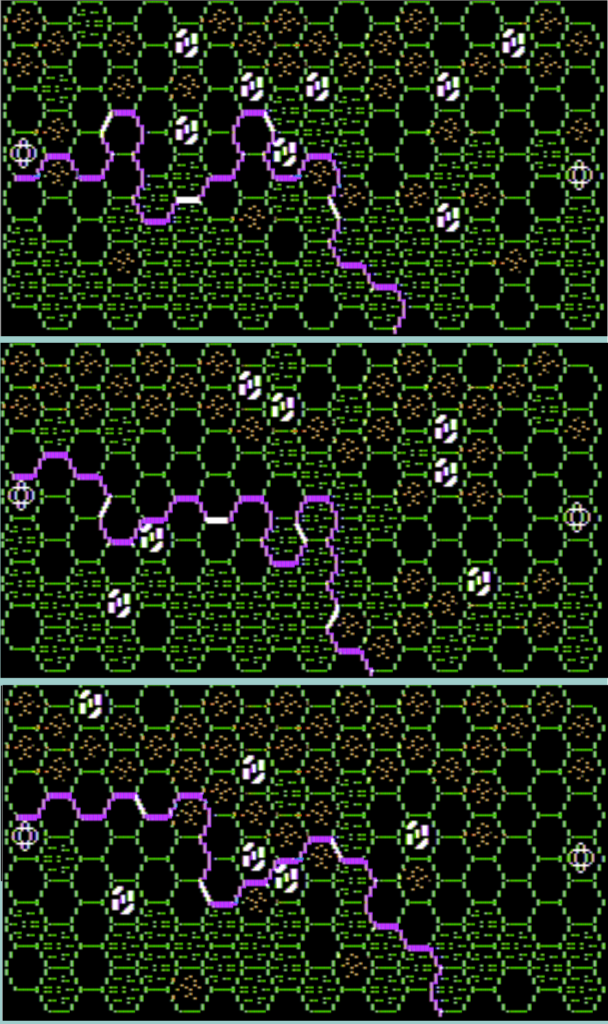
What I like most is how each scenario runs at a different pace. Each scenario lasts 20 turns and takes place on a fairly small map, but even with those limits the reinforcement schedules (your own and the one of your opponent) force you to change your tactics during the battle and even depending on the location in the battle.
- In Invasion and Highway, you need to attack aggressively before the enemy overwhelms you, but at the same time you need to play your paratroopers conservatively,
- In Bridgehead, you need to be extremely aggressive immediately after landing your paratroopers to occupy the bridge and chase the garrisons, then move in full defense until the reinforcements arrive,
- In Advance to Contact, well, it all depends on the map and on what your and your opponent’s first units are (tanks, or infantry)
This pace is reinforced by how Keating designed the reorganization rule. By giving a very high reorganization potential to the initial German units, he forces the allied player to actively hunt the garrisons early on before they can become powerful units. By giving terrible reorganization potential to the paratroopers, he makes sure they cannot “heal” and simulates their lack of supplies.
In a nutshell, I find the scenario design in Operation Apocalypse better than Panzer General and countless other clones, where each scenario has only one, maximum two “moods”.
Those were the cool parts.
As for the issues, the first one is that obviously there are only four scenarios. After roughly one hour for each scenario, you will have finished the game, and if you won you will not have much reason to come back.
The other problem I see with Operation Apocalypse is how “unit-intensive” it is. Each battle has between 20 or 30 units in total for each side – and that’s a lot, especially since units are quite healthy (15 is standard, but 20+ strength is common for paratroopers or AI-controlled units) and the worst CRT result is only 3 damage. It did not show too much in my AAR, but it makes the turns slow and sometimes tedious, as units must be killed by a thousand cuts. I sometimes had vibes of those late Panzer General scenarios where there are hundreds of soviet units to destroy. I did not enjoy that part.
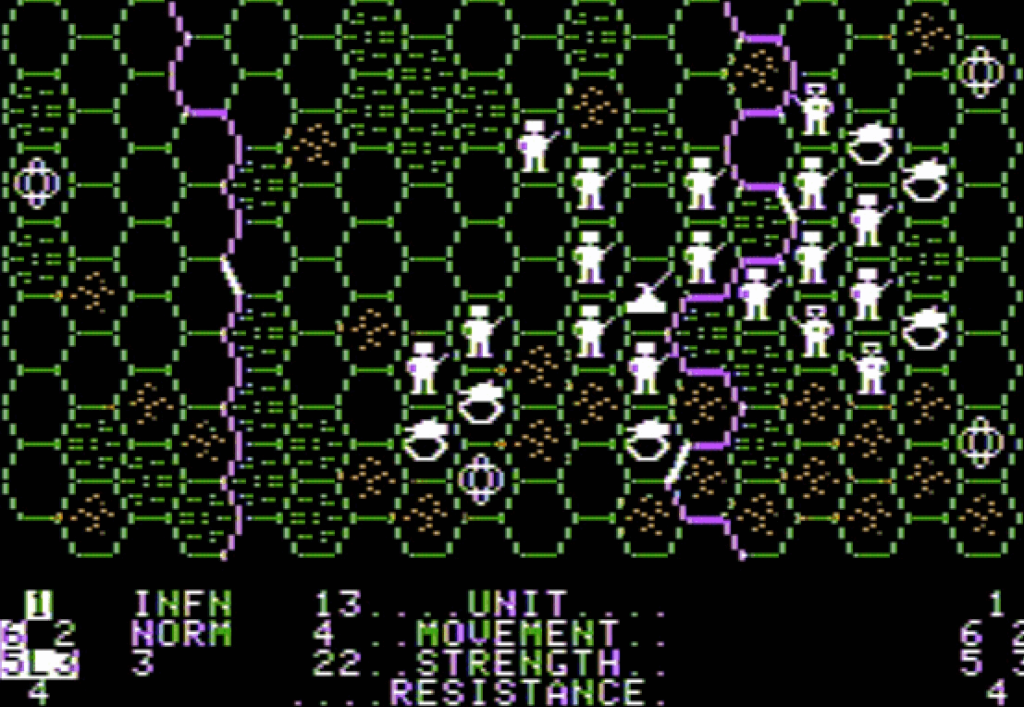
The AI is solid in defense and in particular knows the strategic value of bridges, but totally at loss in the first scenario as it is more open. I have to remove one point for forcing the player to either show their move to the AI, or play blind. Forty years later, I still wanted to say “Come on”.
Small amusing peculiarity of the game : there is an “automatic” mode where the AI plays against itself for 5 turns, presumably for demos.
Rating : Quite good
E. Fun and Replayability
As you can guess by now, I had some fun with the game, only diminished by the unresponsiveness of the AI in the first scenario and by those long moments waiting for a dozen units to move and play their attack. I recommend you try it.
On the other hand, it is not replayable, except maybe the first scenario.
Rating : Acceptable
F. Final rating
It is the very first game I recommend, but only if you are an absolute fan of Panzer General style of games and not too turned off by simple graphics and obsolete UI. For everyone else, it is obsolete, despite the skill of its design.
Rating : Well-designed, but obsolete.
Contemporary Reviews
The game received a string of excellent reviews.
George Miller in Creative Computing (December 1981) complained a bit about the slowness of the game (10 seconds for the movement of one unit !) but praised the randomization of battlefields, giving according to him “hundreds of hours of playing pleasure“.
Paul Todd in Computer Gaming World (January 1982) could not really find any weakness : “the program itself is great“. He compared Operation Apocalypse to Rebel Force and found it superior in every way. It was fast, it was “high resolution“, and Todd even marveled that “you cannot make an illegal move.” In the same issue of Computer Gaming World, Russell Sipe even proposes a way to calculate the result of a campaign depending on your performance in individual battles. Sadly, with a defeat in the Invasion scenario, my result would have been an automatic “German Strategic Victory” with the comment “Operation Sea Lion is revived“. Oh well, sorry, I guess.
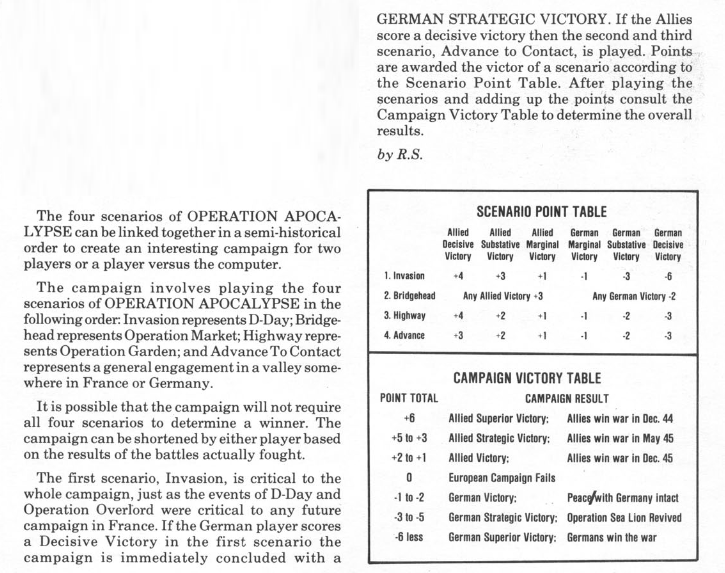
Those glorious days for Operation Apocalypse would not last. The last review I could find is in the 1982 book of Apple Computer Software. Whoever wrote this review was not familiar with combat result tables, and therefore stated “the greatest difficulty with the game is confusingly written documentation. Real study is required” and then another paragraph warning readers how complex the game is – not leaving much space for a real review.
From 1983 onward, the game pretty much stopped being mentioned, except in the SSI catalog, and even there it disappeared in early 1984 – replaced by later Keating games. By the time Computer Gaming World published its 1991 exhaustive list of computer wargames, Operation Apocalypse is missing, seemingly having been dropped off the face of the earth (and keep in mind that the list included every single one of the Squadron Leader games, and two iterations of Computer Air Combat).
An undeserved ending for a solid game, but its innovations would find a new home in Keating’s later games.
If you are curious, the complete description of the available scenarios :
